Strategic Business Analysis and Planning: Four Seasons Hotels
VerifiedAdded on 2023/01/11
|12
|3971
|35
Report
AI Summary
This report provides a comprehensive analysis of the business strategy employed by Four Seasons Hotels & Resorts. It begins with an introduction to the hospitality industry and defines business strategy within this context. The report then delves into a macro-environment analysis using the PESTEL framework, examining political, economic, social, technological, environmental, and legal factors influencing the hotel chain. An internal environment analysis is conducted using SWOT and VRIO analyses to assess the company's strengths, weaknesses, opportunities, threats, and strategic capabilities. Furthermore, Porter's five forces model is applied to evaluate the competitive landscape. The report concludes by synthesizing these analyses and considering the application of various strategic models, theories, and concepts relevant to the hospitality sector, providing a holistic view of Four Seasons' strategic planning and its positioning within the global luxury hotel market.
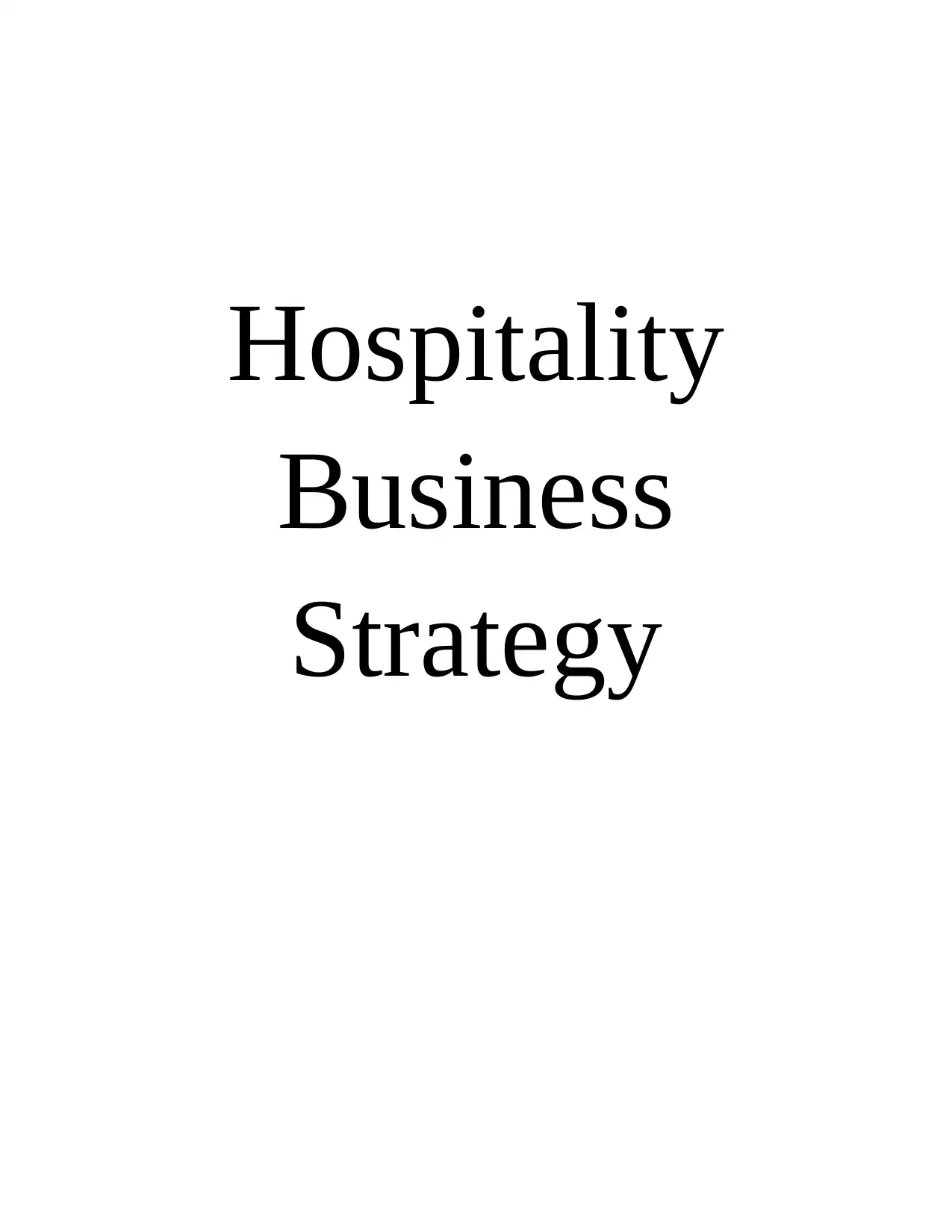
Hospitality
Business
Strategy
Business
Strategy
Paraphrase This Document
Need a fresh take? Get an instant paraphrase of this document with our AI Paraphraser
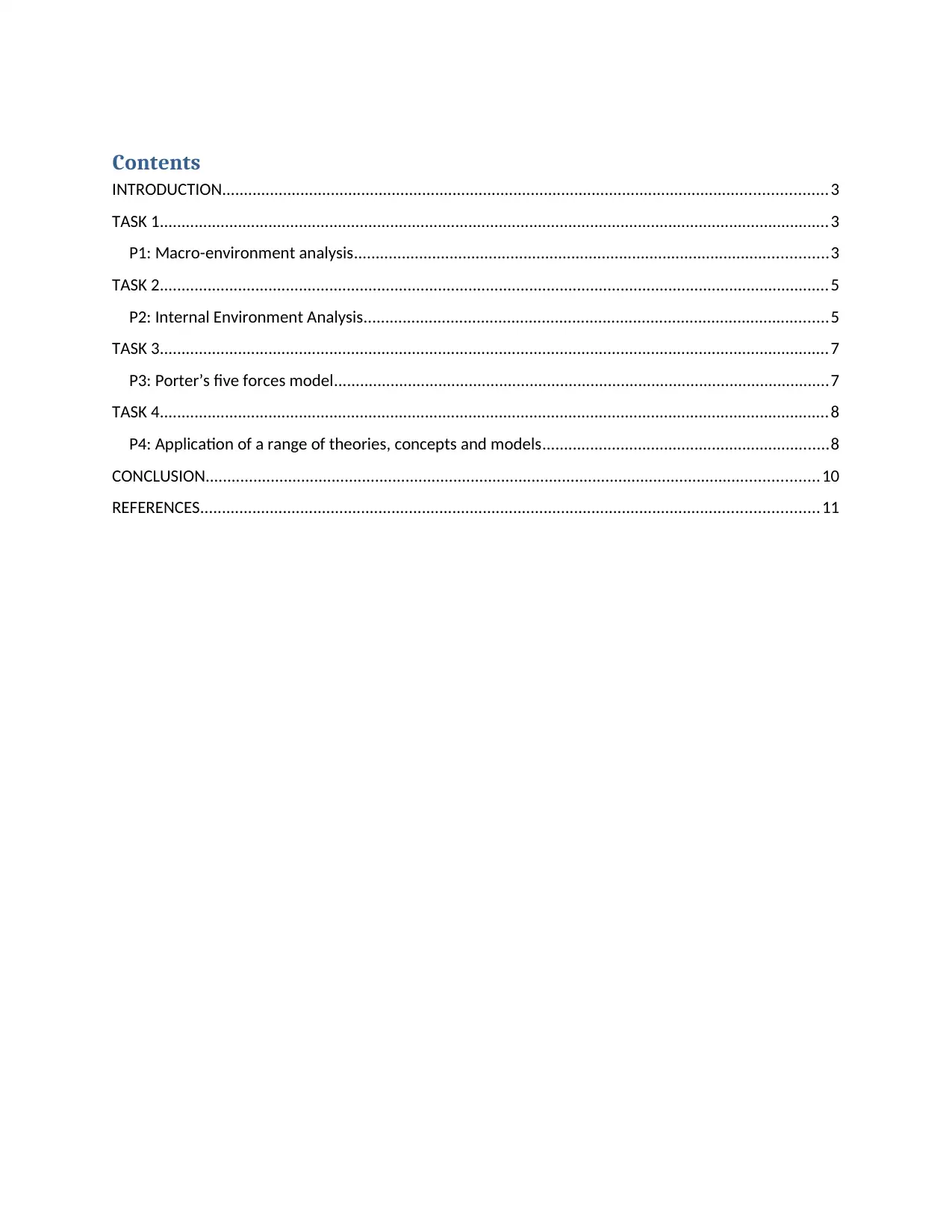
Contents
INTRODUCTION...........................................................................................................................................3
TASK 1..........................................................................................................................................................3
P1: Macro-environment analysis.............................................................................................................3
TASK 2..........................................................................................................................................................5
P2: Internal Environment Analysis...........................................................................................................5
TASK 3..........................................................................................................................................................7
P3: Porter’s five forces model..................................................................................................................7
TASK 4..........................................................................................................................................................8
P4: Application of a range of theories, concepts and models..................................................................8
CONCLUSION.............................................................................................................................................10
REFERENCES..............................................................................................................................................11
INTRODUCTION...........................................................................................................................................3
TASK 1..........................................................................................................................................................3
P1: Macro-environment analysis.............................................................................................................3
TASK 2..........................................................................................................................................................5
P2: Internal Environment Analysis...........................................................................................................5
TASK 3..........................................................................................................................................................7
P3: Porter’s five forces model..................................................................................................................7
TASK 4..........................................................................................................................................................8
P4: Application of a range of theories, concepts and models..................................................................8
CONCLUSION.............................................................................................................................................10
REFERENCES..............................................................................................................................................11
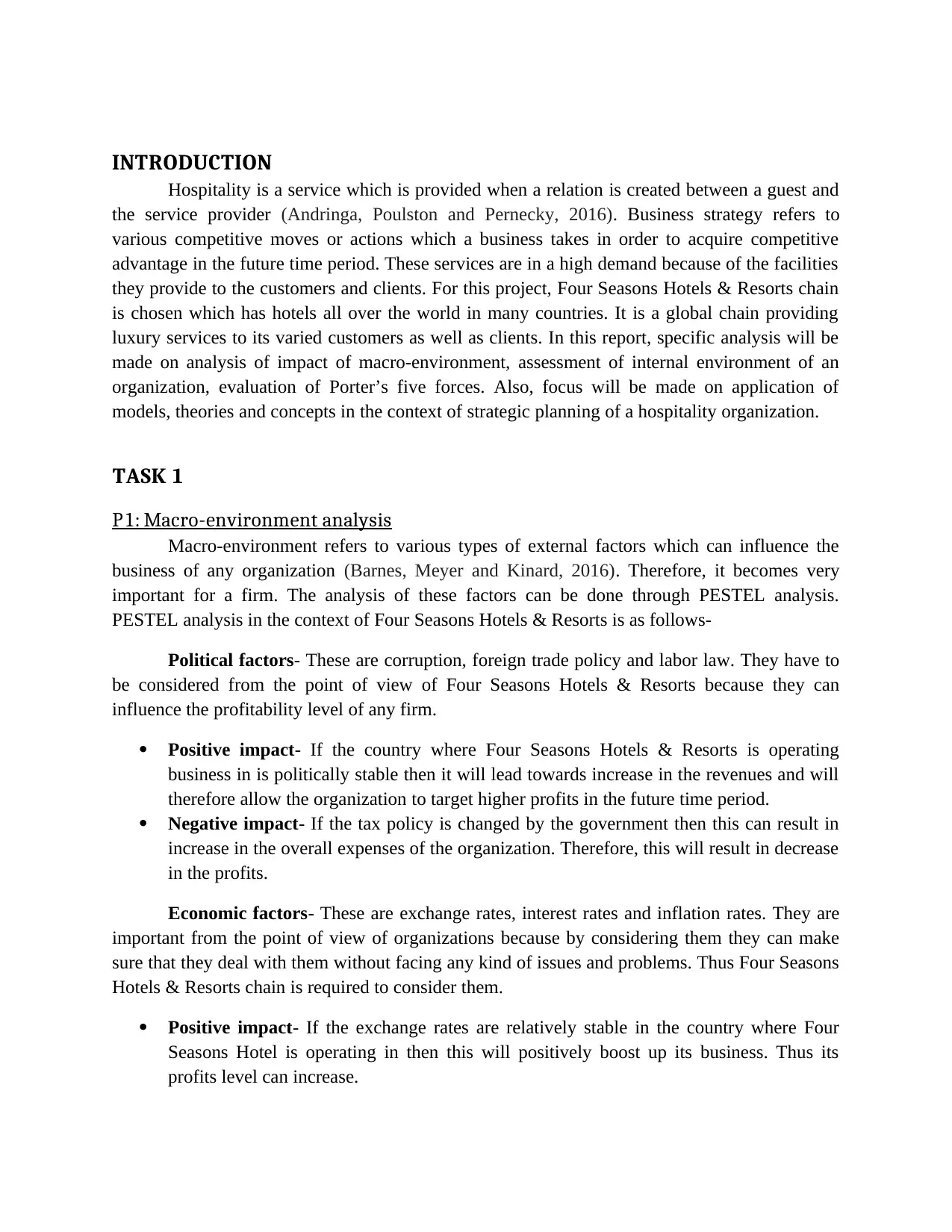
INTRODUCTION
Hospitality is a service which is provided when a relation is created between a guest and
the service provider (Andringa, Poulston and Pernecky, 2016). Business strategy refers to
various competitive moves or actions which a business takes in order to acquire competitive
advantage in the future time period. These services are in a high demand because of the facilities
they provide to the customers and clients. For this project, Four Seasons Hotels & Resorts chain
is chosen which has hotels all over the world in many countries. It is a global chain providing
luxury services to its varied customers as well as clients. In this report, specific analysis will be
made on analysis of impact of macro-environment, assessment of internal environment of an
organization, evaluation of Porter’s five forces. Also, focus will be made on application of
models, theories and concepts in the context of strategic planning of a hospitality organization.
TASK 1
P1: Macro-environment analysis
Macro-environment refers to various types of external factors which can influence the
business of any organization (Barnes, Meyer and Kinard, 2016). Therefore, it becomes very
important for a firm. The analysis of these factors can be done through PESTEL analysis.
PESTEL analysis in the context of Four Seasons Hotels & Resorts is as follows-
Political factors- These are corruption, foreign trade policy and labor law. They have to
be considered from the point of view of Four Seasons Hotels & Resorts because they can
influence the profitability level of any firm.
Positive impact- If the country where Four Seasons Hotels & Resorts is operating
business in is politically stable then it will lead towards increase in the revenues and will
therefore allow the organization to target higher profits in the future time period.
Negative impact- If the tax policy is changed by the government then this can result in
increase in the overall expenses of the organization. Therefore, this will result in decrease
in the profits.
Economic factors- These are exchange rates, interest rates and inflation rates. They are
important from the point of view of organizations because by considering them they can make
sure that they deal with them without facing any kind of issues and problems. Thus Four Seasons
Hotels & Resorts chain is required to consider them.
Positive impact- If the exchange rates are relatively stable in the country where Four
Seasons Hotel is operating in then this will positively boost up its business. Thus its
profits level can increase.
Hospitality is a service which is provided when a relation is created between a guest and
the service provider (Andringa, Poulston and Pernecky, 2016). Business strategy refers to
various competitive moves or actions which a business takes in order to acquire competitive
advantage in the future time period. These services are in a high demand because of the facilities
they provide to the customers and clients. For this project, Four Seasons Hotels & Resorts chain
is chosen which has hotels all over the world in many countries. It is a global chain providing
luxury services to its varied customers as well as clients. In this report, specific analysis will be
made on analysis of impact of macro-environment, assessment of internal environment of an
organization, evaluation of Porter’s five forces. Also, focus will be made on application of
models, theories and concepts in the context of strategic planning of a hospitality organization.
TASK 1
P1: Macro-environment analysis
Macro-environment refers to various types of external factors which can influence the
business of any organization (Barnes, Meyer and Kinard, 2016). Therefore, it becomes very
important for a firm. The analysis of these factors can be done through PESTEL analysis.
PESTEL analysis in the context of Four Seasons Hotels & Resorts is as follows-
Political factors- These are corruption, foreign trade policy and labor law. They have to
be considered from the point of view of Four Seasons Hotels & Resorts because they can
influence the profitability level of any firm.
Positive impact- If the country where Four Seasons Hotels & Resorts is operating
business in is politically stable then it will lead towards increase in the revenues and will
therefore allow the organization to target higher profits in the future time period.
Negative impact- If the tax policy is changed by the government then this can result in
increase in the overall expenses of the organization. Therefore, this will result in decrease
in the profits.
Economic factors- These are exchange rates, interest rates and inflation rates. They are
important from the point of view of organizations because by considering them they can make
sure that they deal with them without facing any kind of issues and problems. Thus Four Seasons
Hotels & Resorts chain is required to consider them.
Positive impact- If the exchange rates are relatively stable in the country where Four
Seasons Hotel is operating in then this will positively boost up its business. Thus its
profits level can increase.
⊘ This is a preview!⊘
Do you want full access?
Subscribe today to unlock all pages.

Trusted by 1+ million students worldwide
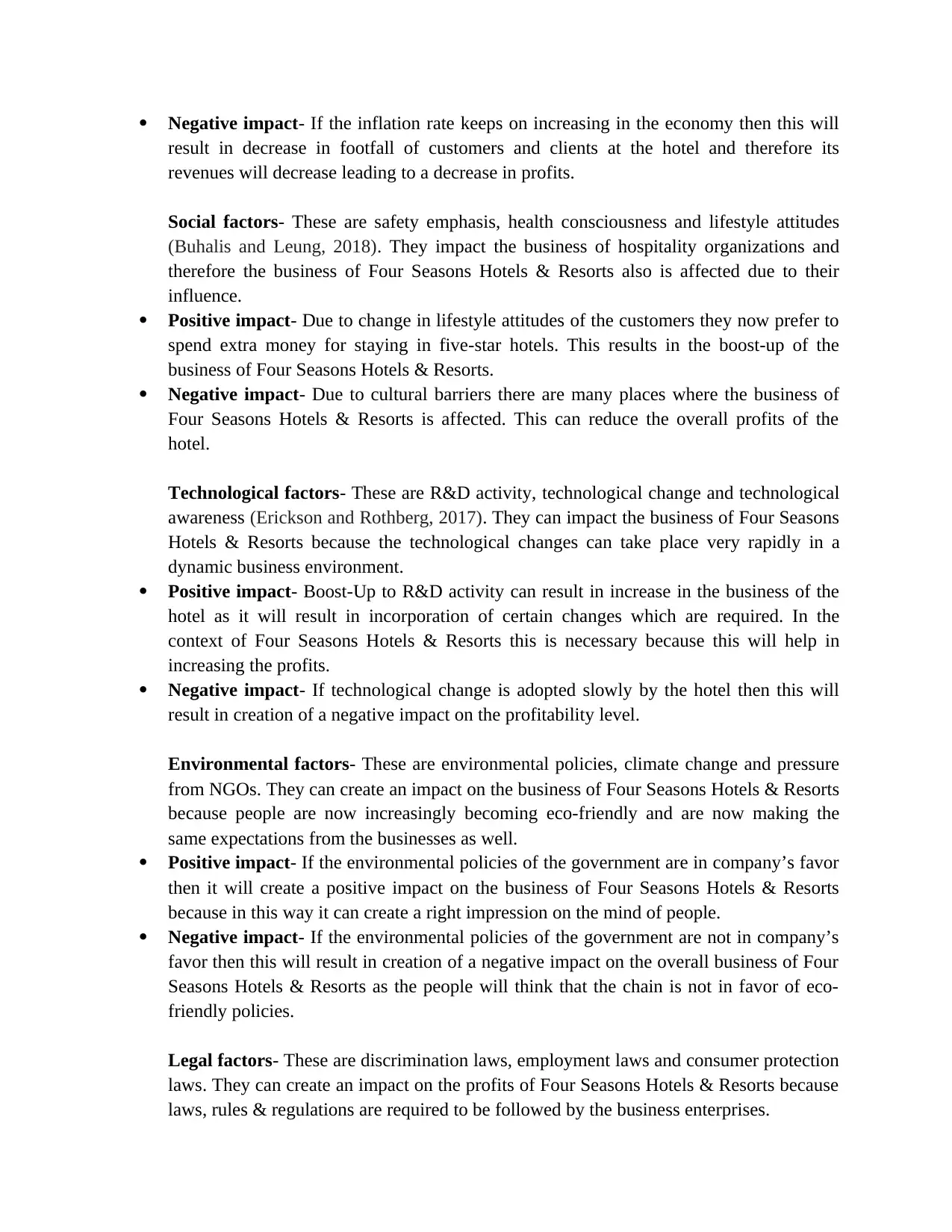
Negative impact- If the inflation rate keeps on increasing in the economy then this will
result in decrease in footfall of customers and clients at the hotel and therefore its
revenues will decrease leading to a decrease in profits.
Social factors- These are safety emphasis, health consciousness and lifestyle attitudes
(Buhalis and Leung, 2018). They impact the business of hospitality organizations and
therefore the business of Four Seasons Hotels & Resorts also is affected due to their
influence.
Positive impact- Due to change in lifestyle attitudes of the customers they now prefer to
spend extra money for staying in five-star hotels. This results in the boost-up of the
business of Four Seasons Hotels & Resorts.
Negative impact- Due to cultural barriers there are many places where the business of
Four Seasons Hotels & Resorts is affected. This can reduce the overall profits of the
hotel.
Technological factors- These are R&D activity, technological change and technological
awareness (Erickson and Rothberg, 2017). They can impact the business of Four Seasons
Hotels & Resorts because the technological changes can take place very rapidly in a
dynamic business environment.
Positive impact- Boost-Up to R&D activity can result in increase in the business of the
hotel as it will result in incorporation of certain changes which are required. In the
context of Four Seasons Hotels & Resorts this is necessary because this will help in
increasing the profits.
Negative impact- If technological change is adopted slowly by the hotel then this will
result in creation of a negative impact on the profitability level.
Environmental factors- These are environmental policies, climate change and pressure
from NGOs. They can create an impact on the business of Four Seasons Hotels & Resorts
because people are now increasingly becoming eco-friendly and are now making the
same expectations from the businesses as well.
Positive impact- If the environmental policies of the government are in company’s favor
then it will create a positive impact on the business of Four Seasons Hotels & Resorts
because in this way it can create a right impression on the mind of people.
Negative impact- If the environmental policies of the government are not in company’s
favor then this will result in creation of a negative impact on the overall business of Four
Seasons Hotels & Resorts as the people will think that the chain is not in favor of eco-
friendly policies.
Legal factors- These are discrimination laws, employment laws and consumer protection
laws. They can create an impact on the profits of Four Seasons Hotels & Resorts because
laws, rules & regulations are required to be followed by the business enterprises.
result in decrease in footfall of customers and clients at the hotel and therefore its
revenues will decrease leading to a decrease in profits.
Social factors- These are safety emphasis, health consciousness and lifestyle attitudes
(Buhalis and Leung, 2018). They impact the business of hospitality organizations and
therefore the business of Four Seasons Hotels & Resorts also is affected due to their
influence.
Positive impact- Due to change in lifestyle attitudes of the customers they now prefer to
spend extra money for staying in five-star hotels. This results in the boost-up of the
business of Four Seasons Hotels & Resorts.
Negative impact- Due to cultural barriers there are many places where the business of
Four Seasons Hotels & Resorts is affected. This can reduce the overall profits of the
hotel.
Technological factors- These are R&D activity, technological change and technological
awareness (Erickson and Rothberg, 2017). They can impact the business of Four Seasons
Hotels & Resorts because the technological changes can take place very rapidly in a
dynamic business environment.
Positive impact- Boost-Up to R&D activity can result in increase in the business of the
hotel as it will result in incorporation of certain changes which are required. In the
context of Four Seasons Hotels & Resorts this is necessary because this will help in
increasing the profits.
Negative impact- If technological change is adopted slowly by the hotel then this will
result in creation of a negative impact on the profitability level.
Environmental factors- These are environmental policies, climate change and pressure
from NGOs. They can create an impact on the business of Four Seasons Hotels & Resorts
because people are now increasingly becoming eco-friendly and are now making the
same expectations from the businesses as well.
Positive impact- If the environmental policies of the government are in company’s favor
then it will create a positive impact on the business of Four Seasons Hotels & Resorts
because in this way it can create a right impression on the mind of people.
Negative impact- If the environmental policies of the government are not in company’s
favor then this will result in creation of a negative impact on the overall business of Four
Seasons Hotels & Resorts as the people will think that the chain is not in favor of eco-
friendly policies.
Legal factors- These are discrimination laws, employment laws and consumer protection
laws. They can create an impact on the profits of Four Seasons Hotels & Resorts because
laws, rules & regulations are required to be followed by the business enterprises.
Paraphrase This Document
Need a fresh take? Get an instant paraphrase of this document with our AI Paraphraser
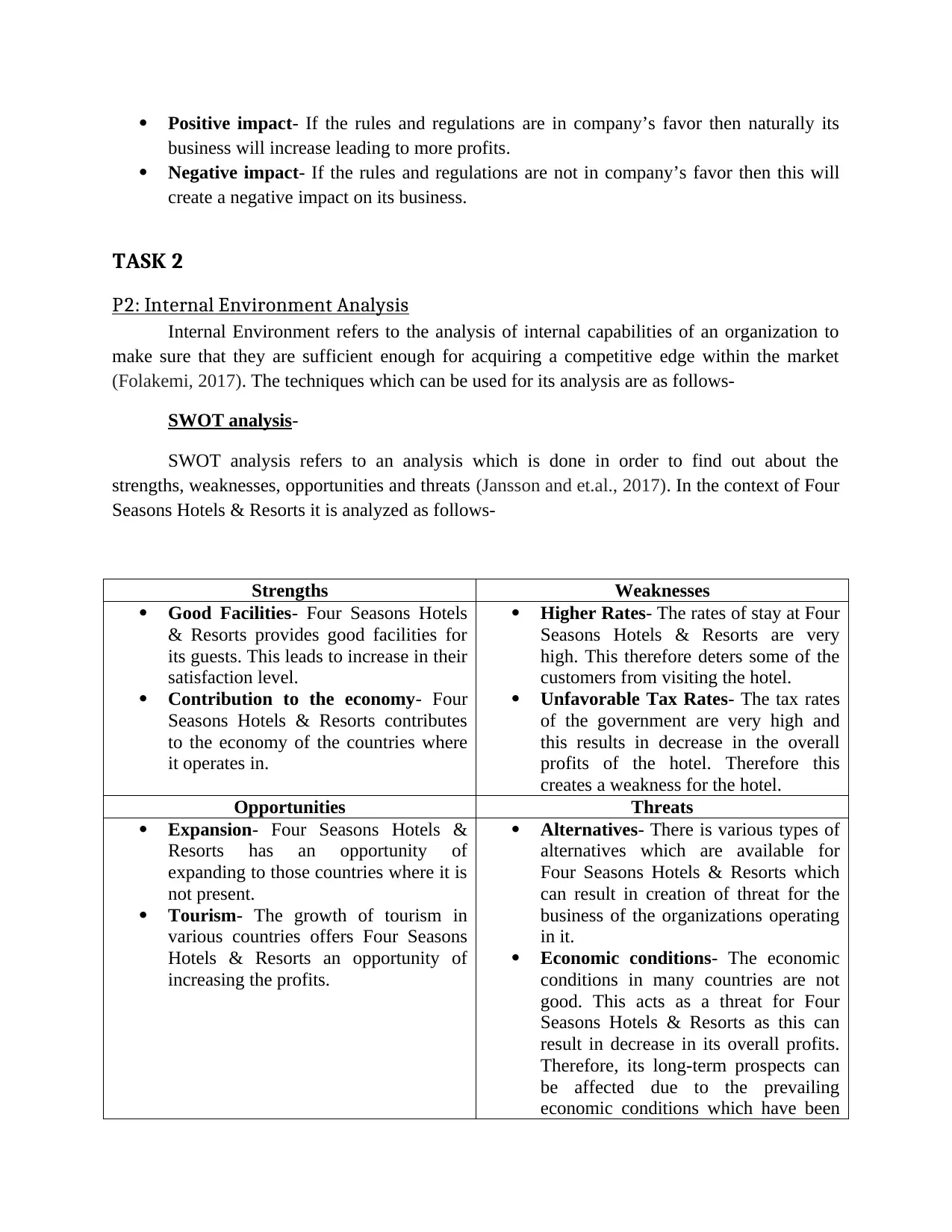
Positive impact- If the rules and regulations are in company’s favor then naturally its
business will increase leading to more profits.
Negative impact- If the rules and regulations are not in company’s favor then this will
create a negative impact on its business.
TASK 2
P2: Internal Environment Analysis
Internal Environment refers to the analysis of internal capabilities of an organization to
make sure that they are sufficient enough for acquiring a competitive edge within the market
(Folakemi, 2017). The techniques which can be used for its analysis are as follows-
SWOT analysis-
SWOT analysis refers to an analysis which is done in order to find out about the
strengths, weaknesses, opportunities and threats (Jansson and et.al., 2017). In the context of Four
Seasons Hotels & Resorts it is analyzed as follows-
Strengths Weaknesses
Good Facilities- Four Seasons Hotels
& Resorts provides good facilities for
its guests. This leads to increase in their
satisfaction level.
Contribution to the economy- Four
Seasons Hotels & Resorts contributes
to the economy of the countries where
it operates in.
Higher Rates- The rates of stay at Four
Seasons Hotels & Resorts are very
high. This therefore deters some of the
customers from visiting the hotel.
Unfavorable Tax Rates- The tax rates
of the government are very high and
this results in decrease in the overall
profits of the hotel. Therefore this
creates a weakness for the hotel.
Opportunities Threats
Expansion- Four Seasons Hotels &
Resorts has an opportunity of
expanding to those countries where it is
not present.
Tourism- The growth of tourism in
various countries offers Four Seasons
Hotels & Resorts an opportunity of
increasing the profits.
Alternatives- There is various types of
alternatives which are available for
Four Seasons Hotels & Resorts which
can result in creation of threat for the
business of the organizations operating
in it.
Economic conditions- The economic
conditions in many countries are not
good. This acts as a threat for Four
Seasons Hotels & Resorts as this can
result in decrease in its overall profits.
Therefore, its long-term prospects can
be affected due to the prevailing
economic conditions which have been
business will increase leading to more profits.
Negative impact- If the rules and regulations are not in company’s favor then this will
create a negative impact on its business.
TASK 2
P2: Internal Environment Analysis
Internal Environment refers to the analysis of internal capabilities of an organization to
make sure that they are sufficient enough for acquiring a competitive edge within the market
(Folakemi, 2017). The techniques which can be used for its analysis are as follows-
SWOT analysis-
SWOT analysis refers to an analysis which is done in order to find out about the
strengths, weaknesses, opportunities and threats (Jansson and et.al., 2017). In the context of Four
Seasons Hotels & Resorts it is analyzed as follows-
Strengths Weaknesses
Good Facilities- Four Seasons Hotels
& Resorts provides good facilities for
its guests. This leads to increase in their
satisfaction level.
Contribution to the economy- Four
Seasons Hotels & Resorts contributes
to the economy of the countries where
it operates in.
Higher Rates- The rates of stay at Four
Seasons Hotels & Resorts are very
high. This therefore deters some of the
customers from visiting the hotel.
Unfavorable Tax Rates- The tax rates
of the government are very high and
this results in decrease in the overall
profits of the hotel. Therefore this
creates a weakness for the hotel.
Opportunities Threats
Expansion- Four Seasons Hotels &
Resorts has an opportunity of
expanding to those countries where it is
not present.
Tourism- The growth of tourism in
various countries offers Four Seasons
Hotels & Resorts an opportunity of
increasing the profits.
Alternatives- There is various types of
alternatives which are available for
Four Seasons Hotels & Resorts which
can result in creation of threat for the
business of the organizations operating
in it.
Economic conditions- The economic
conditions in many countries are not
good. This acts as a threat for Four
Seasons Hotels & Resorts as this can
result in decrease in its overall profits.
Therefore, its long-term prospects can
be affected due to the prevailing
economic conditions which have been
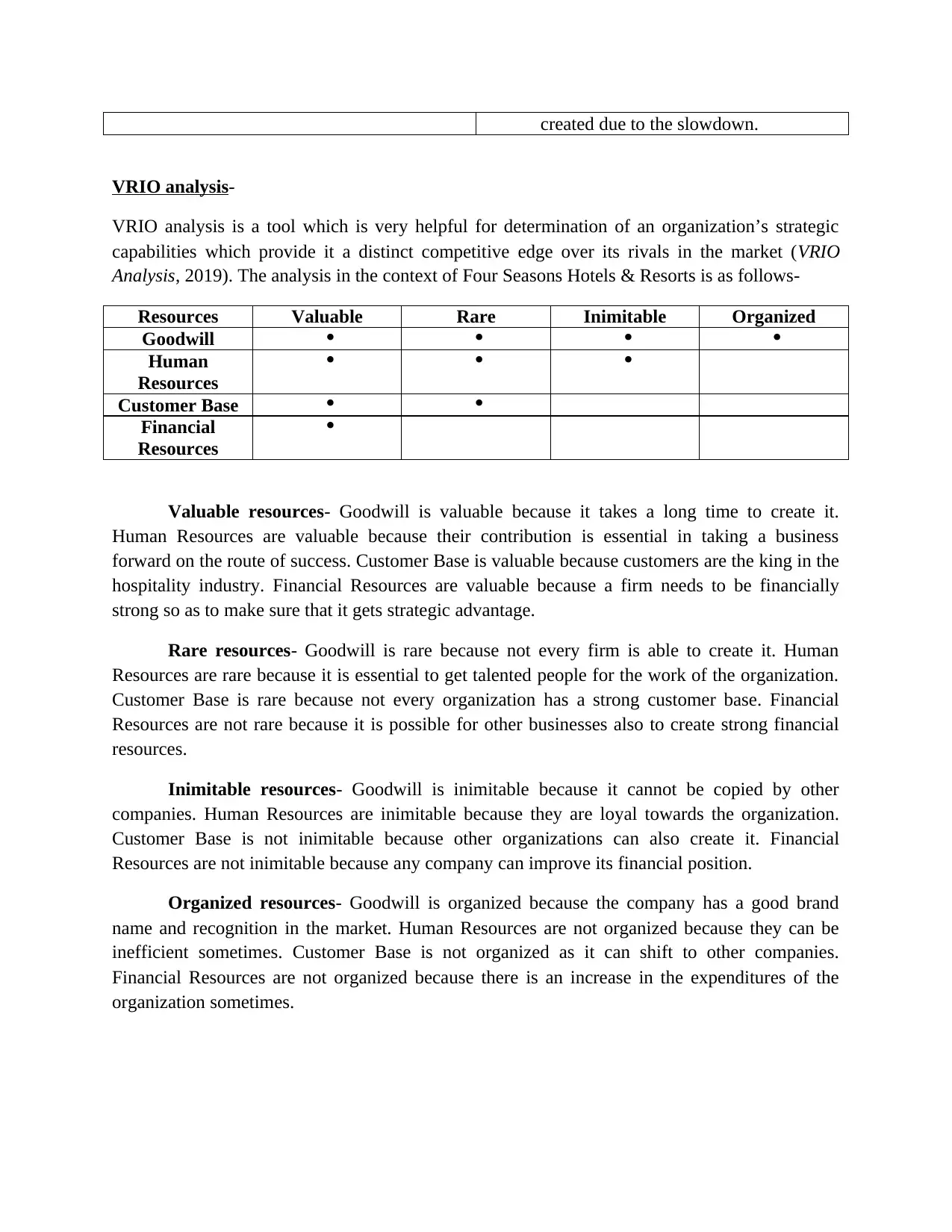
created due to the slowdown.
VRIO analysis-
VRIO analysis is a tool which is very helpful for determination of an organization’s strategic
capabilities which provide it a distinct competitive edge over its rivals in the market (VRIO
Analysis, 2019). The analysis in the context of Four Seasons Hotels & Resorts is as follows-
Resources Valuable Rare Inimitable Organized
Goodwill
Human
Resources
Customer Base
Financial
Resources
Valuable resources- Goodwill is valuable because it takes a long time to create it.
Human Resources are valuable because their contribution is essential in taking a business
forward on the route of success. Customer Base is valuable because customers are the king in the
hospitality industry. Financial Resources are valuable because a firm needs to be financially
strong so as to make sure that it gets strategic advantage.
Rare resources- Goodwill is rare because not every firm is able to create it. Human
Resources are rare because it is essential to get talented people for the work of the organization.
Customer Base is rare because not every organization has a strong customer base. Financial
Resources are not rare because it is possible for other businesses also to create strong financial
resources.
Inimitable resources- Goodwill is inimitable because it cannot be copied by other
companies. Human Resources are inimitable because they are loyal towards the organization.
Customer Base is not inimitable because other organizations can also create it. Financial
Resources are not inimitable because any company can improve its financial position.
Organized resources- Goodwill is organized because the company has a good brand
name and recognition in the market. Human Resources are not organized because they can be
inefficient sometimes. Customer Base is not organized as it can shift to other companies.
Financial Resources are not organized because there is an increase in the expenditures of the
organization sometimes.
VRIO analysis-
VRIO analysis is a tool which is very helpful for determination of an organization’s strategic
capabilities which provide it a distinct competitive edge over its rivals in the market (VRIO
Analysis, 2019). The analysis in the context of Four Seasons Hotels & Resorts is as follows-
Resources Valuable Rare Inimitable Organized
Goodwill
Human
Resources
Customer Base
Financial
Resources
Valuable resources- Goodwill is valuable because it takes a long time to create it.
Human Resources are valuable because their contribution is essential in taking a business
forward on the route of success. Customer Base is valuable because customers are the king in the
hospitality industry. Financial Resources are valuable because a firm needs to be financially
strong so as to make sure that it gets strategic advantage.
Rare resources- Goodwill is rare because not every firm is able to create it. Human
Resources are rare because it is essential to get talented people for the work of the organization.
Customer Base is rare because not every organization has a strong customer base. Financial
Resources are not rare because it is possible for other businesses also to create strong financial
resources.
Inimitable resources- Goodwill is inimitable because it cannot be copied by other
companies. Human Resources are inimitable because they are loyal towards the organization.
Customer Base is not inimitable because other organizations can also create it. Financial
Resources are not inimitable because any company can improve its financial position.
Organized resources- Goodwill is organized because the company has a good brand
name and recognition in the market. Human Resources are not organized because they can be
inefficient sometimes. Customer Base is not organized as it can shift to other companies.
Financial Resources are not organized because there is an increase in the expenditures of the
organization sometimes.
⊘ This is a preview!⊘
Do you want full access?
Subscribe today to unlock all pages.

Trusted by 1+ million students worldwide
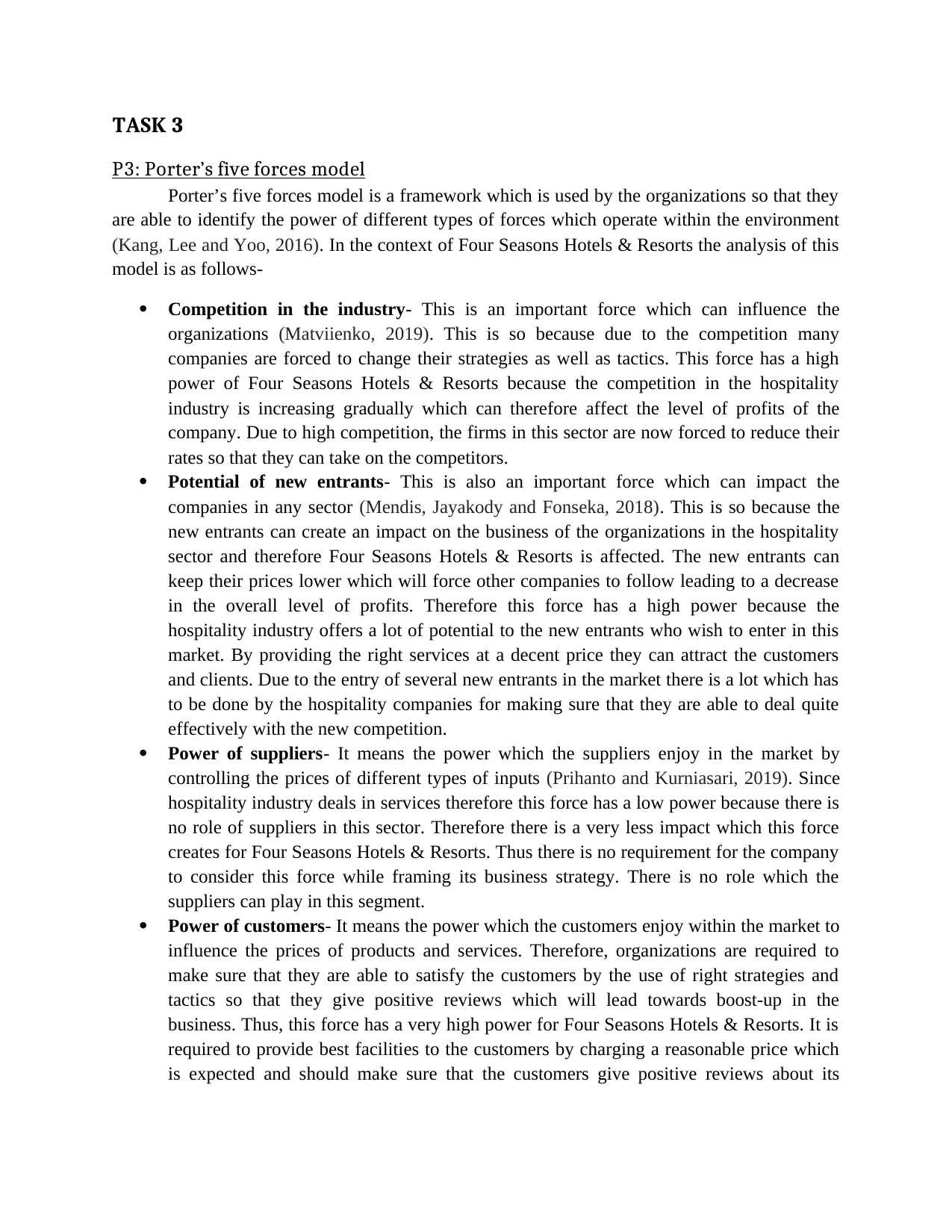
TASK 3
P3: Porter’s five forces model
Porter’s five forces model is a framework which is used by the organizations so that they
are able to identify the power of different types of forces which operate within the environment
(Kang, Lee and Yoo, 2016). In the context of Four Seasons Hotels & Resorts the analysis of this
model is as follows-
Competition in the industry- This is an important force which can influence the
organizations (Matviienko, 2019). This is so because due to the competition many
companies are forced to change their strategies as well as tactics. This force has a high
power of Four Seasons Hotels & Resorts because the competition in the hospitality
industry is increasing gradually which can therefore affect the level of profits of the
company. Due to high competition, the firms in this sector are now forced to reduce their
rates so that they can take on the competitors.
Potential of new entrants- This is also an important force which can impact the
companies in any sector (Mendis, Jayakody and Fonseka, 2018). This is so because the
new entrants can create an impact on the business of the organizations in the hospitality
sector and therefore Four Seasons Hotels & Resorts is affected. The new entrants can
keep their prices lower which will force other companies to follow leading to a decrease
in the overall level of profits. Therefore this force has a high power because the
hospitality industry offers a lot of potential to the new entrants who wish to enter in this
market. By providing the right services at a decent price they can attract the customers
and clients. Due to the entry of several new entrants in the market there is a lot which has
to be done by the hospitality companies for making sure that they are able to deal quite
effectively with the new competition.
Power of suppliers- It means the power which the suppliers enjoy in the market by
controlling the prices of different types of inputs (Prihanto and Kurniasari, 2019). Since
hospitality industry deals in services therefore this force has a low power because there is
no role of suppliers in this sector. Therefore there is a very less impact which this force
creates for Four Seasons Hotels & Resorts. Thus there is no requirement for the company
to consider this force while framing its business strategy. There is no role which the
suppliers can play in this segment.
Power of customers- It means the power which the customers enjoy within the market to
influence the prices of products and services. Therefore, organizations are required to
make sure that they are able to satisfy the customers by the use of right strategies and
tactics so that they give positive reviews which will lead towards boost-up in the
business. Thus, this force has a very high power for Four Seasons Hotels & Resorts. It is
required to provide best facilities to the customers by charging a reasonable price which
is expected and should make sure that the customers give positive reviews about its
P3: Porter’s five forces model
Porter’s five forces model is a framework which is used by the organizations so that they
are able to identify the power of different types of forces which operate within the environment
(Kang, Lee and Yoo, 2016). In the context of Four Seasons Hotels & Resorts the analysis of this
model is as follows-
Competition in the industry- This is an important force which can influence the
organizations (Matviienko, 2019). This is so because due to the competition many
companies are forced to change their strategies as well as tactics. This force has a high
power of Four Seasons Hotels & Resorts because the competition in the hospitality
industry is increasing gradually which can therefore affect the level of profits of the
company. Due to high competition, the firms in this sector are now forced to reduce their
rates so that they can take on the competitors.
Potential of new entrants- This is also an important force which can impact the
companies in any sector (Mendis, Jayakody and Fonseka, 2018). This is so because the
new entrants can create an impact on the business of the organizations in the hospitality
sector and therefore Four Seasons Hotels & Resorts is affected. The new entrants can
keep their prices lower which will force other companies to follow leading to a decrease
in the overall level of profits. Therefore this force has a high power because the
hospitality industry offers a lot of potential to the new entrants who wish to enter in this
market. By providing the right services at a decent price they can attract the customers
and clients. Due to the entry of several new entrants in the market there is a lot which has
to be done by the hospitality companies for making sure that they are able to deal quite
effectively with the new competition.
Power of suppliers- It means the power which the suppliers enjoy in the market by
controlling the prices of different types of inputs (Prihanto and Kurniasari, 2019). Since
hospitality industry deals in services therefore this force has a low power because there is
no role of suppliers in this sector. Therefore there is a very less impact which this force
creates for Four Seasons Hotels & Resorts. Thus there is no requirement for the company
to consider this force while framing its business strategy. There is no role which the
suppliers can play in this segment.
Power of customers- It means the power which the customers enjoy within the market to
influence the prices of products and services. Therefore, organizations are required to
make sure that they are able to satisfy the customers by the use of right strategies and
tactics so that they give positive reviews which will lead towards boost-up in the
business. Thus, this force has a very high power for Four Seasons Hotels & Resorts. It is
required to provide best facilities to the customers by charging a reasonable price which
is expected and should make sure that the customers give positive reviews about its
Paraphrase This Document
Need a fresh take? Get an instant paraphrase of this document with our AI Paraphraser
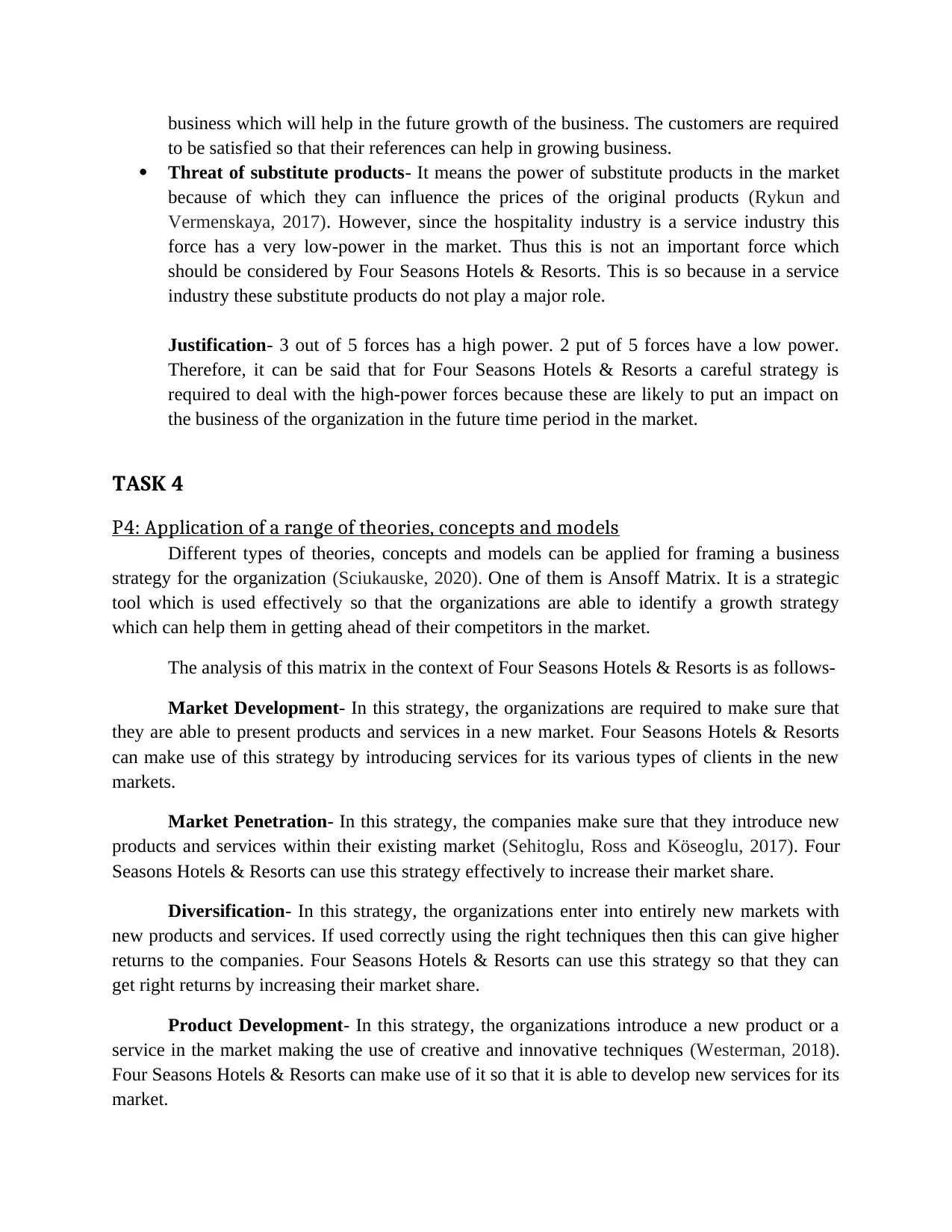
business which will help in the future growth of the business. The customers are required
to be satisfied so that their references can help in growing business.
Threat of substitute products- It means the power of substitute products in the market
because of which they can influence the prices of the original products (Rykun and
Vermenskaya, 2017). However, since the hospitality industry is a service industry this
force has a very low-power in the market. Thus this is not an important force which
should be considered by Four Seasons Hotels & Resorts. This is so because in a service
industry these substitute products do not play a major role.
Justification- 3 out of 5 forces has a high power. 2 put of 5 forces have a low power.
Therefore, it can be said that for Four Seasons Hotels & Resorts a careful strategy is
required to deal with the high-power forces because these are likely to put an impact on
the business of the organization in the future time period in the market.
TASK 4
P4: Application of a range of theories, concepts and models
Different types of theories, concepts and models can be applied for framing a business
strategy for the organization (Sciukauske, 2020). One of them is Ansoff Matrix. It is a strategic
tool which is used effectively so that the organizations are able to identify a growth strategy
which can help them in getting ahead of their competitors in the market.
The analysis of this matrix in the context of Four Seasons Hotels & Resorts is as follows-
Market Development- In this strategy, the organizations are required to make sure that
they are able to present products and services in a new market. Four Seasons Hotels & Resorts
can make use of this strategy by introducing services for its various types of clients in the new
markets.
Market Penetration- In this strategy, the companies make sure that they introduce new
products and services within their existing market (Sehitoglu, Ross and Köseoglu, 2017). Four
Seasons Hotels & Resorts can use this strategy effectively to increase their market share.
Diversification- In this strategy, the organizations enter into entirely new markets with
new products and services. If used correctly using the right techniques then this can give higher
returns to the companies. Four Seasons Hotels & Resorts can use this strategy so that they can
get right returns by increasing their market share.
Product Development- In this strategy, the organizations introduce a new product or a
service in the market making the use of creative and innovative techniques (Westerman, 2018).
Four Seasons Hotels & Resorts can make use of it so that it is able to develop new services for its
market.
to be satisfied so that their references can help in growing business.
Threat of substitute products- It means the power of substitute products in the market
because of which they can influence the prices of the original products (Rykun and
Vermenskaya, 2017). However, since the hospitality industry is a service industry this
force has a very low-power in the market. Thus this is not an important force which
should be considered by Four Seasons Hotels & Resorts. This is so because in a service
industry these substitute products do not play a major role.
Justification- 3 out of 5 forces has a high power. 2 put of 5 forces have a low power.
Therefore, it can be said that for Four Seasons Hotels & Resorts a careful strategy is
required to deal with the high-power forces because these are likely to put an impact on
the business of the organization in the future time period in the market.
TASK 4
P4: Application of a range of theories, concepts and models
Different types of theories, concepts and models can be applied for framing a business
strategy for the organization (Sciukauske, 2020). One of them is Ansoff Matrix. It is a strategic
tool which is used effectively so that the organizations are able to identify a growth strategy
which can help them in getting ahead of their competitors in the market.
The analysis of this matrix in the context of Four Seasons Hotels & Resorts is as follows-
Market Development- In this strategy, the organizations are required to make sure that
they are able to present products and services in a new market. Four Seasons Hotels & Resorts
can make use of this strategy by introducing services for its various types of clients in the new
markets.
Market Penetration- In this strategy, the companies make sure that they introduce new
products and services within their existing market (Sehitoglu, Ross and Köseoglu, 2017). Four
Seasons Hotels & Resorts can use this strategy effectively to increase their market share.
Diversification- In this strategy, the organizations enter into entirely new markets with
new products and services. If used correctly using the right techniques then this can give higher
returns to the companies. Four Seasons Hotels & Resorts can use this strategy so that they can
get right returns by increasing their market share.
Product Development- In this strategy, the organizations introduce a new product or a
service in the market making the use of creative and innovative techniques (Westerman, 2018).
Four Seasons Hotels & Resorts can make use of it so that it is able to develop new services for its
market.
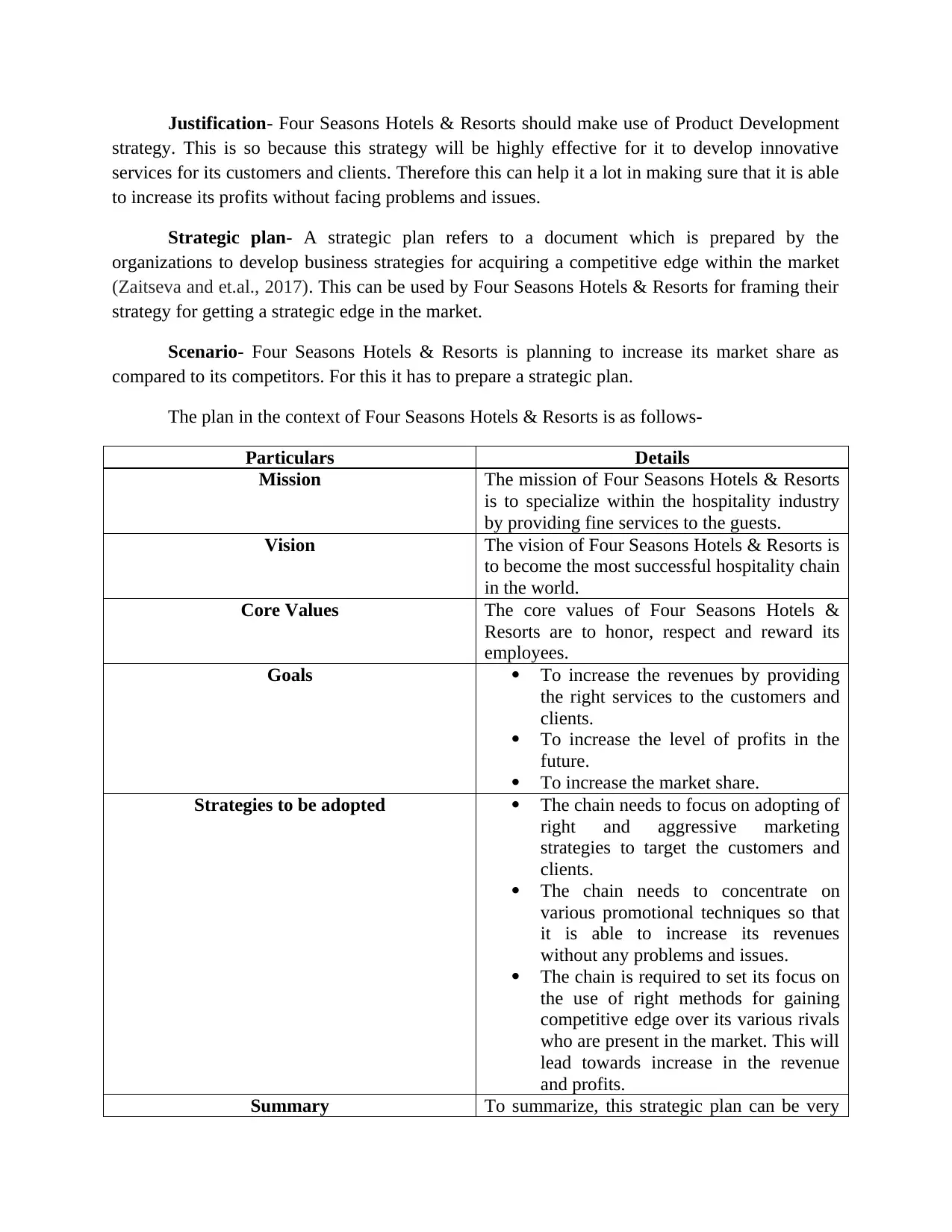
Justification- Four Seasons Hotels & Resorts should make use of Product Development
strategy. This is so because this strategy will be highly effective for it to develop innovative
services for its customers and clients. Therefore this can help it a lot in making sure that it is able
to increase its profits without facing problems and issues.
Strategic plan- A strategic plan refers to a document which is prepared by the
organizations to develop business strategies for acquiring a competitive edge within the market
(Zaitseva and et.al., 2017). This can be used by Four Seasons Hotels & Resorts for framing their
strategy for getting a strategic edge in the market.
Scenario- Four Seasons Hotels & Resorts is planning to increase its market share as
compared to its competitors. For this it has to prepare a strategic plan.
The plan in the context of Four Seasons Hotels & Resorts is as follows-
Particulars Details
Mission The mission of Four Seasons Hotels & Resorts
is to specialize within the hospitality industry
by providing fine services to the guests.
Vision The vision of Four Seasons Hotels & Resorts is
to become the most successful hospitality chain
in the world.
Core Values The core values of Four Seasons Hotels &
Resorts are to honor, respect and reward its
employees.
Goals To increase the revenues by providing
the right services to the customers and
clients.
To increase the level of profits in the
future.
To increase the market share.
Strategies to be adopted The chain needs to focus on adopting of
right and aggressive marketing
strategies to target the customers and
clients.
The chain needs to concentrate on
various promotional techniques so that
it is able to increase its revenues
without any problems and issues.
The chain is required to set its focus on
the use of right methods for gaining
competitive edge over its various rivals
who are present in the market. This will
lead towards increase in the revenue
and profits.
Summary To summarize, this strategic plan can be very
strategy. This is so because this strategy will be highly effective for it to develop innovative
services for its customers and clients. Therefore this can help it a lot in making sure that it is able
to increase its profits without facing problems and issues.
Strategic plan- A strategic plan refers to a document which is prepared by the
organizations to develop business strategies for acquiring a competitive edge within the market
(Zaitseva and et.al., 2017). This can be used by Four Seasons Hotels & Resorts for framing their
strategy for getting a strategic edge in the market.
Scenario- Four Seasons Hotels & Resorts is planning to increase its market share as
compared to its competitors. For this it has to prepare a strategic plan.
The plan in the context of Four Seasons Hotels & Resorts is as follows-
Particulars Details
Mission The mission of Four Seasons Hotels & Resorts
is to specialize within the hospitality industry
by providing fine services to the guests.
Vision The vision of Four Seasons Hotels & Resorts is
to become the most successful hospitality chain
in the world.
Core Values The core values of Four Seasons Hotels &
Resorts are to honor, respect and reward its
employees.
Goals To increase the revenues by providing
the right services to the customers and
clients.
To increase the level of profits in the
future.
To increase the market share.
Strategies to be adopted The chain needs to focus on adopting of
right and aggressive marketing
strategies to target the customers and
clients.
The chain needs to concentrate on
various promotional techniques so that
it is able to increase its revenues
without any problems and issues.
The chain is required to set its focus on
the use of right methods for gaining
competitive edge over its various rivals
who are present in the market. This will
lead towards increase in the revenue
and profits.
Summary To summarize, this strategic plan can be very
⊘ This is a preview!⊘
Do you want full access?
Subscribe today to unlock all pages.

Trusted by 1+ million students worldwide
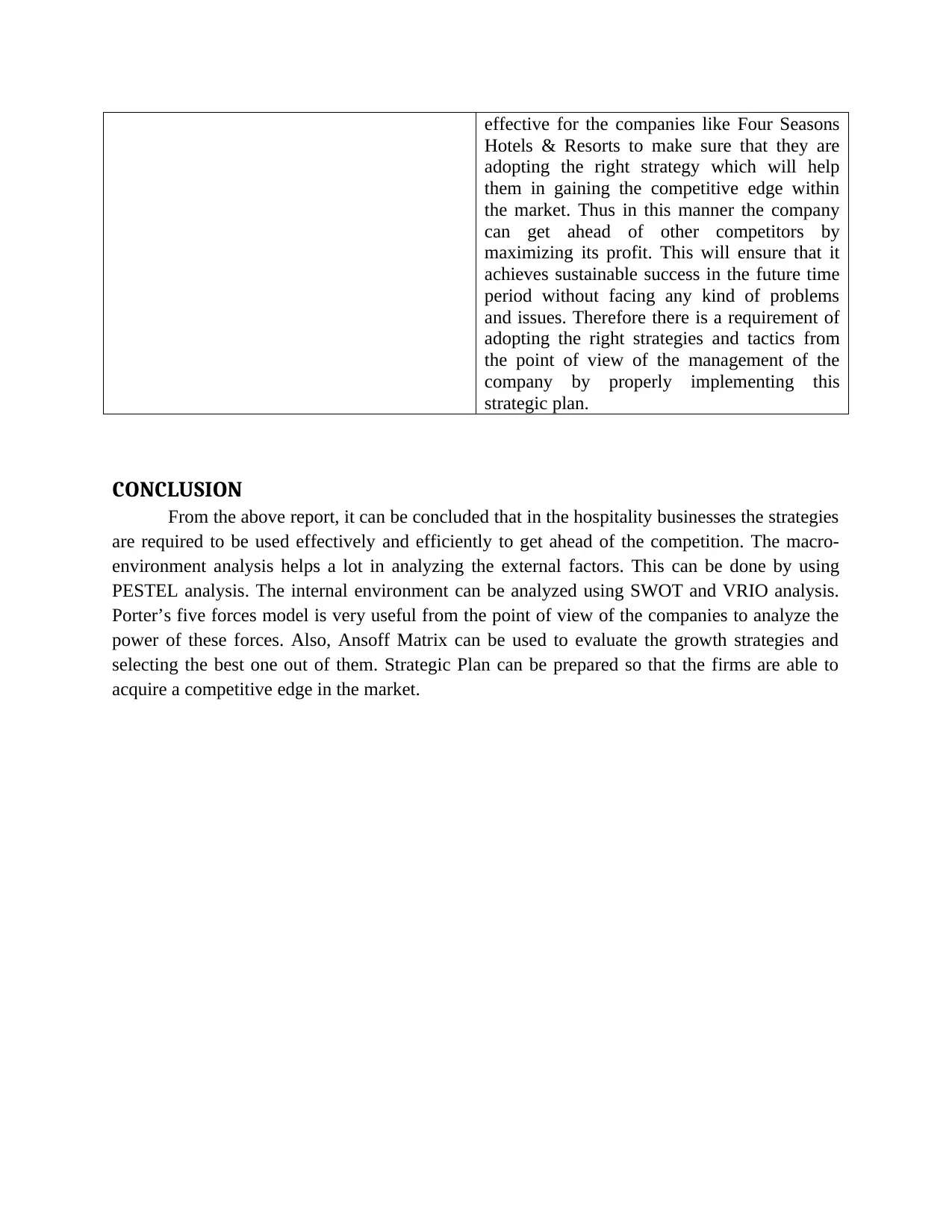
effective for the companies like Four Seasons
Hotels & Resorts to make sure that they are
adopting the right strategy which will help
them in gaining the competitive edge within
the market. Thus in this manner the company
can get ahead of other competitors by
maximizing its profit. This will ensure that it
achieves sustainable success in the future time
period without facing any kind of problems
and issues. Therefore there is a requirement of
adopting the right strategies and tactics from
the point of view of the management of the
company by properly implementing this
strategic plan.
CONCLUSION
From the above report, it can be concluded that in the hospitality businesses the strategies
are required to be used effectively and efficiently to get ahead of the competition. The macro-
environment analysis helps a lot in analyzing the external factors. This can be done by using
PESTEL analysis. The internal environment can be analyzed using SWOT and VRIO analysis.
Porter’s five forces model is very useful from the point of view of the companies to analyze the
power of these forces. Also, Ansoff Matrix can be used to evaluate the growth strategies and
selecting the best one out of them. Strategic Plan can be prepared so that the firms are able to
acquire a competitive edge in the market.
Hotels & Resorts to make sure that they are
adopting the right strategy which will help
them in gaining the competitive edge within
the market. Thus in this manner the company
can get ahead of other competitors by
maximizing its profit. This will ensure that it
achieves sustainable success in the future time
period without facing any kind of problems
and issues. Therefore there is a requirement of
adopting the right strategies and tactics from
the point of view of the management of the
company by properly implementing this
strategic plan.
CONCLUSION
From the above report, it can be concluded that in the hospitality businesses the strategies
are required to be used effectively and efficiently to get ahead of the competition. The macro-
environment analysis helps a lot in analyzing the external factors. This can be done by using
PESTEL analysis. The internal environment can be analyzed using SWOT and VRIO analysis.
Porter’s five forces model is very useful from the point of view of the companies to analyze the
power of these forces. Also, Ansoff Matrix can be used to evaluate the growth strategies and
selecting the best one out of them. Strategic Plan can be prepared so that the firms are able to
acquire a competitive edge in the market.
Paraphrase This Document
Need a fresh take? Get an instant paraphrase of this document with our AI Paraphraser
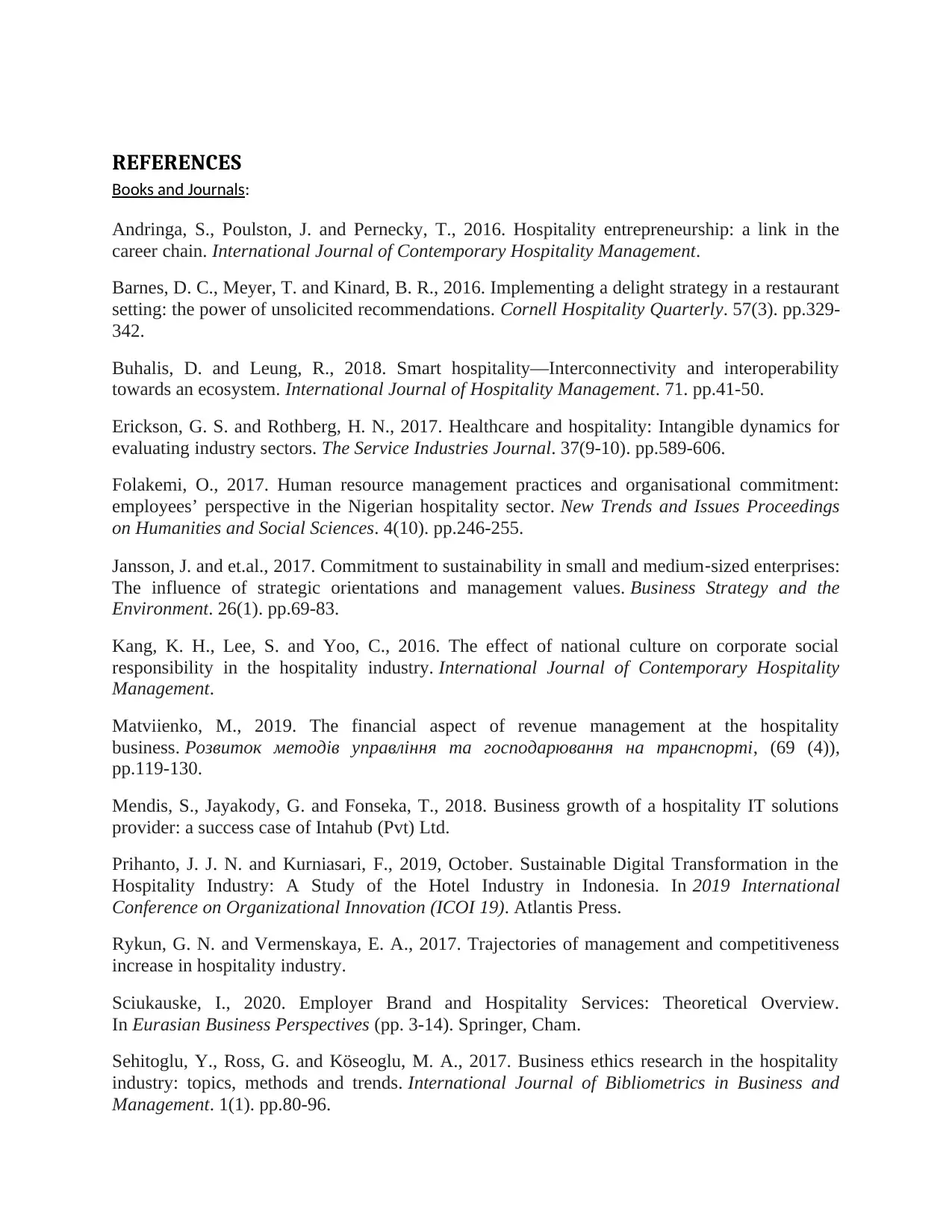
REFERENCES
Books and Journals:
Andringa, S., Poulston, J. and Pernecky, T., 2016. Hospitality entrepreneurship: a link in the
career chain. International Journal of Contemporary Hospitality Management.
Barnes, D. C., Meyer, T. and Kinard, B. R., 2016. Implementing a delight strategy in a restaurant
setting: the power of unsolicited recommendations. Cornell Hospitality Quarterly. 57(3). pp.329-
342.
Buhalis, D. and Leung, R., 2018. Smart hospitality—Interconnectivity and interoperability
towards an ecosystem. International Journal of Hospitality Management. 71. pp.41-50.
Erickson, G. S. and Rothberg, H. N., 2017. Healthcare and hospitality: Intangible dynamics for
evaluating industry sectors. The Service Industries Journal. 37(9-10). pp.589-606.
Folakemi, O., 2017. Human resource management practices and organisational commitment:
employees’ perspective in the Nigerian hospitality sector. New Trends and Issues Proceedings
on Humanities and Social Sciences. 4(10). pp.246-255.
Jansson, J. and et.al., 2017. Commitment to sustainability in small and medium‐sized enterprises:
The influence of strategic orientations and management values. Business Strategy and the
Environment. 26(1). pp.69-83.
Kang, K. H., Lee, S. and Yoo, C., 2016. The effect of national culture on corporate social
responsibility in the hospitality industry. International Journal of Contemporary Hospitality
Management.
Matviienko, M., 2019. The financial aspect of revenue management at the hospitality
business. Розвиток методів управління та господарювання на транспорті, (69 (4)),
pp.119-130.
Mendis, S., Jayakody, G. and Fonseka, T., 2018. Business growth of a hospitality IT solutions
provider: a success case of Intahub (Pvt) Ltd.
Prihanto, J. J. N. and Kurniasari, F., 2019, October. Sustainable Digital Transformation in the
Hospitality Industry: A Study of the Hotel Industry in Indonesia. In 2019 International
Conference on Organizational Innovation (ICOI 19). Atlantis Press.
Rykun, G. N. and Vermenskaya, E. A., 2017. Trajectories of management and competitiveness
increase in hospitality industry.
Sciukauske, I., 2020. Employer Brand and Hospitality Services: Theoretical Overview.
In Eurasian Business Perspectives (pp. 3-14). Springer, Cham.
Sehitoglu, Y., Ross, G. and Köseoglu, M. A., 2017. Business ethics research in the hospitality
industry: topics, methods and trends. International Journal of Bibliometrics in Business and
Management. 1(1). pp.80-96.
Books and Journals:
Andringa, S., Poulston, J. and Pernecky, T., 2016. Hospitality entrepreneurship: a link in the
career chain. International Journal of Contemporary Hospitality Management.
Barnes, D. C., Meyer, T. and Kinard, B. R., 2016. Implementing a delight strategy in a restaurant
setting: the power of unsolicited recommendations. Cornell Hospitality Quarterly. 57(3). pp.329-
342.
Buhalis, D. and Leung, R., 2018. Smart hospitality—Interconnectivity and interoperability
towards an ecosystem. International Journal of Hospitality Management. 71. pp.41-50.
Erickson, G. S. and Rothberg, H. N., 2017. Healthcare and hospitality: Intangible dynamics for
evaluating industry sectors. The Service Industries Journal. 37(9-10). pp.589-606.
Folakemi, O., 2017. Human resource management practices and organisational commitment:
employees’ perspective in the Nigerian hospitality sector. New Trends and Issues Proceedings
on Humanities and Social Sciences. 4(10). pp.246-255.
Jansson, J. and et.al., 2017. Commitment to sustainability in small and medium‐sized enterprises:
The influence of strategic orientations and management values. Business Strategy and the
Environment. 26(1). pp.69-83.
Kang, K. H., Lee, S. and Yoo, C., 2016. The effect of national culture on corporate social
responsibility in the hospitality industry. International Journal of Contemporary Hospitality
Management.
Matviienko, M., 2019. The financial aspect of revenue management at the hospitality
business. Розвиток методів управління та господарювання на транспорті, (69 (4)),
pp.119-130.
Mendis, S., Jayakody, G. and Fonseka, T., 2018. Business growth of a hospitality IT solutions
provider: a success case of Intahub (Pvt) Ltd.
Prihanto, J. J. N. and Kurniasari, F., 2019, October. Sustainable Digital Transformation in the
Hospitality Industry: A Study of the Hotel Industry in Indonesia. In 2019 International
Conference on Organizational Innovation (ICOI 19). Atlantis Press.
Rykun, G. N. and Vermenskaya, E. A., 2017. Trajectories of management and competitiveness
increase in hospitality industry.
Sciukauske, I., 2020. Employer Brand and Hospitality Services: Theoretical Overview.
In Eurasian Business Perspectives (pp. 3-14). Springer, Cham.
Sehitoglu, Y., Ross, G. and Köseoglu, M. A., 2017. Business ethics research in the hospitality
industry: topics, methods and trends. International Journal of Bibliometrics in Business and
Management. 1(1). pp.80-96.
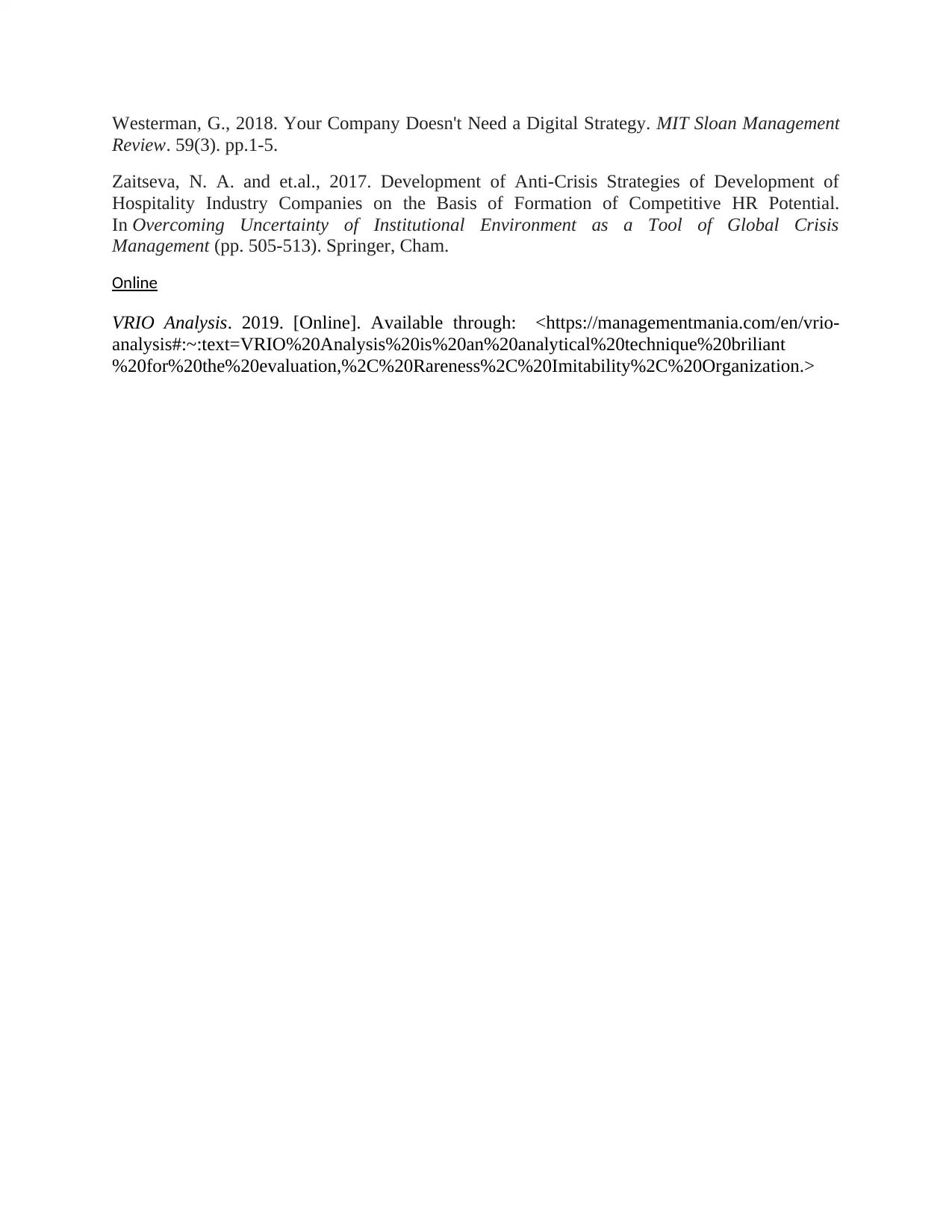
Westerman, G., 2018. Your Company Doesn't Need a Digital Strategy. MIT Sloan Management
Review. 59(3). pp.1-5.
Zaitseva, N. A. and et.al., 2017. Development of Anti-Crisis Strategies of Development of
Hospitality Industry Companies on the Basis of Formation of Competitive HR Potential.
In Overcoming Uncertainty of Institutional Environment as a Tool of Global Crisis
Management (pp. 505-513). Springer, Cham.
Online
VRIO Analysis. 2019. [Online]. Available through: <https://managementmania.com/en/vrio-
analysis#:~:text=VRIO%20Analysis%20is%20an%20analytical%20technique%20briliant
%20for%20the%20evaluation,%2C%20Rareness%2C%20Imitability%2C%20Organization.>
Review. 59(3). pp.1-5.
Zaitseva, N. A. and et.al., 2017. Development of Anti-Crisis Strategies of Development of
Hospitality Industry Companies on the Basis of Formation of Competitive HR Potential.
In Overcoming Uncertainty of Institutional Environment as a Tool of Global Crisis
Management (pp. 505-513). Springer, Cham.
Online
VRIO Analysis. 2019. [Online]. Available through: <https://managementmania.com/en/vrio-
analysis#:~:text=VRIO%20Analysis%20is%20an%20analytical%20technique%20briliant
%20for%20the%20evaluation,%2C%20Rareness%2C%20Imitability%2C%20Organization.>
⊘ This is a preview!⊘
Do you want full access?
Subscribe today to unlock all pages.

Trusted by 1+ million students worldwide
1 out of 12
Related Documents
Your All-in-One AI-Powered Toolkit for Academic Success.
+13062052269
info@desklib.com
Available 24*7 on WhatsApp / Email
![[object Object]](/_next/static/media/star-bottom.7253800d.svg)
Unlock your academic potential
Copyright © 2020–2025 A2Z Services. All Rights Reserved. Developed and managed by ZUCOL.




